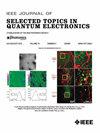Label-Free Rapid Intelligent Diagnosis of Thyroid Cancer
IF 5.1
2区 工程技术
Q1 ENGINEERING, ELECTRICAL & ELECTRONIC
IEEE Journal of Selected Topics in Quantum Electronics
Pub Date : 2025-09-22
DOI:10.1109/JSTQE.2025.3612470
引用次数: 0
Abstract
The annual thyroid cancer incidence has been increasing. Thyroid cancer is categorized as a malignant neoplasm within the endocrine system. Fine-needle aspiration cytology remains the benchmark for thyroid cancer detection; however, the accuracy of the procedure depends on the practitioner’s expertise. Numerous challenges are associated with this process, such as obtaining inadequate cellular samples, mispuncturing the target lesion, and collecting nonrepresentative cell samples. These issues hinder proper cellular evaluation and increase the likelihood of misdiagnosis, ultimately impacting patient outcomes and the treatment trajectory. This research primarily aims to improve the diagnostic accuracy of thyroid cancer by introducing an innovative computer-aided diagnostic tool that leverages advanced deep learning techniques. Second-harmonic microscopy enables the fine extraction of morphological characteristics of collagen fibers within thyroid tissues, revealing significant differences in the distribution and organization of collagen fibers between normal and malignant tissues. In this study, we quantified the morphological alterations of collagen fibers by initially analyzing second-harmonic generation (SHG) images through a collagen scoring system based on feature extraction via least absolute shrinkage and selection operator regression. Model efficacy was assessed using receiver operating characteristic curves. Furthermore, we classified normal and malignant thyroid tissues in the validation cohort through three distinct deep-learning architectures (Mobile Neural Networks Version 3 (MobileNetV3), Visual Geometry Group 16(VGG16), and Pyramid Vision Transformer v2 (PVTv2) in combination with SHG image data. Overall, MobileNetV3 achieved the best classification performance (87.4%). This study无标签快速智能诊断甲状腺癌
甲状腺癌的年发病率一直呈上升趋势。甲状腺癌是内分泌系统的恶性肿瘤。细针穿刺细胞学仍然是甲状腺癌检测的基准;然而,程序的准确性取决于从业者的专业知识。与此过程相关的许多挑战,例如获得不充分的细胞样本,错误地穿刺目标病变,以及收集不具有代表性的细胞样本。这些问题阻碍了适当的细胞评估,增加了误诊的可能性,最终影响了患者的预后和治疗轨迹。本研究主要旨在通过引入一种利用先进深度学习技术的创新计算机辅助诊断工具来提高甲状腺癌的诊断准确性。二次谐波显微镜可以精细提取甲状腺组织内胶原纤维的形态特征,揭示正常组织与恶性组织中胶原纤维分布和组织的显著差异。在这项研究中,我们通过基于最小绝对收缩和选择算子回归的特征提取的胶原评分系统,通过对二次谐波生成(SHG)图像进行初步分析,量化了胶原纤维的形态变化。采用受试者工作特征曲线评价模型疗效。此外,我们通过三种不同的深度学习架构(移动神经网络版本3 (MobileNetV3)、视觉几何组16(VGG16)和金字塔视觉变压器v2 (PVTv2)结合SHG图像数据,对验证队列中的正常和恶性甲状腺组织进行了分类。总的来说,MobileNetV3获得了最好的分类性能(87.4%)。本研究为深度学习算法在区分恶性和正常甲状腺组织方面的有效性提供了初步证据。这一重大进展为临床环境中检测甲状腺癌提供了宝贵的技术支持,并有望提高诊断实践的准确性和效率。
本文章由计算机程序翻译,如有差异,请以英文原文为准。
求助全文
约1分钟内获得全文
求助全文
来源期刊

IEEE Journal of Selected Topics in Quantum Electronics
工程技术-工程:电子与电气
CiteScore
10.60
自引率
2.00%
发文量
212
审稿时长
3 months
期刊介绍:
Papers published in the IEEE Journal of Selected Topics in Quantum Electronics fall within the broad field of science and technology of quantum electronics of a device, subsystem, or system-oriented nature. Each issue is devoted to a specific topic within this broad spectrum. Announcements of the topical areas planned for future issues, along with deadlines for receipt of manuscripts, are published in this Journal and in the IEEE Journal of Quantum Electronics. Generally, the scope of manuscripts appropriate to this Journal is the same as that for the IEEE Journal of Quantum Electronics. Manuscripts are published that report original theoretical and/or experimental research results that advance the scientific and technological base of quantum electronics devices, systems, or applications. The Journal is dedicated toward publishing research results that advance the state of the art or add to the understanding of the generation, amplification, modulation, detection, waveguiding, or propagation characteristics of coherent electromagnetic radiation having sub-millimeter and shorter wavelengths. In order to be suitable for publication in this Journal, the content of manuscripts concerned with subject-related research must have a potential impact on advancing the technological base of quantum electronic devices, systems, and/or applications. Potential authors of subject-related research have the responsibility of pointing out this potential impact. System-oriented manuscripts must be concerned with systems that perform a function previously unavailable or that outperform previously established systems that did not use quantum electronic components or concepts. Tutorial and review papers are by invitation only.
 求助内容:
求助内容: 应助结果提醒方式:
应助结果提醒方式:


